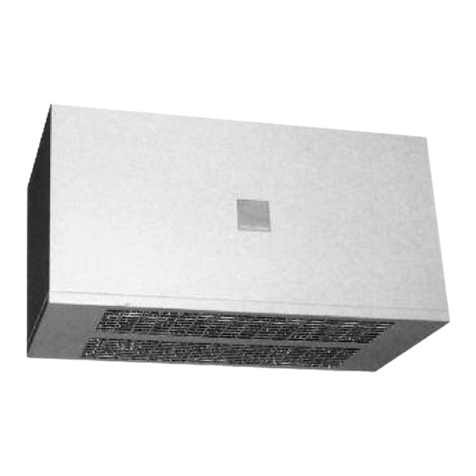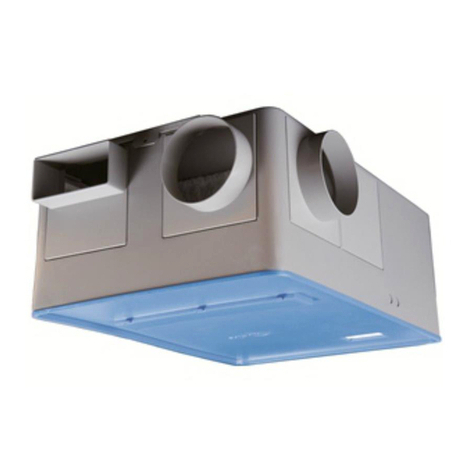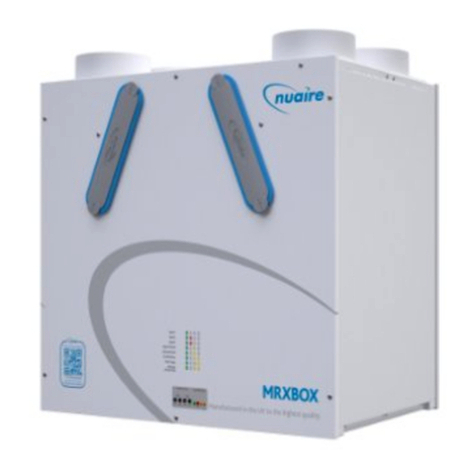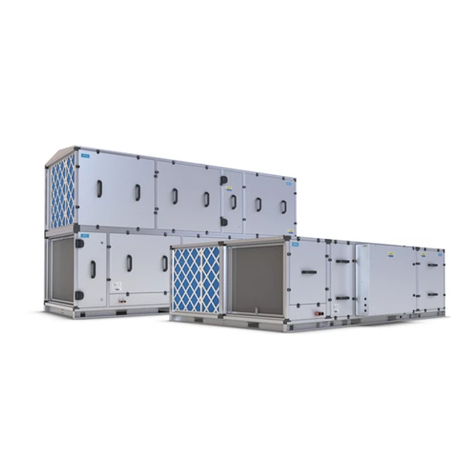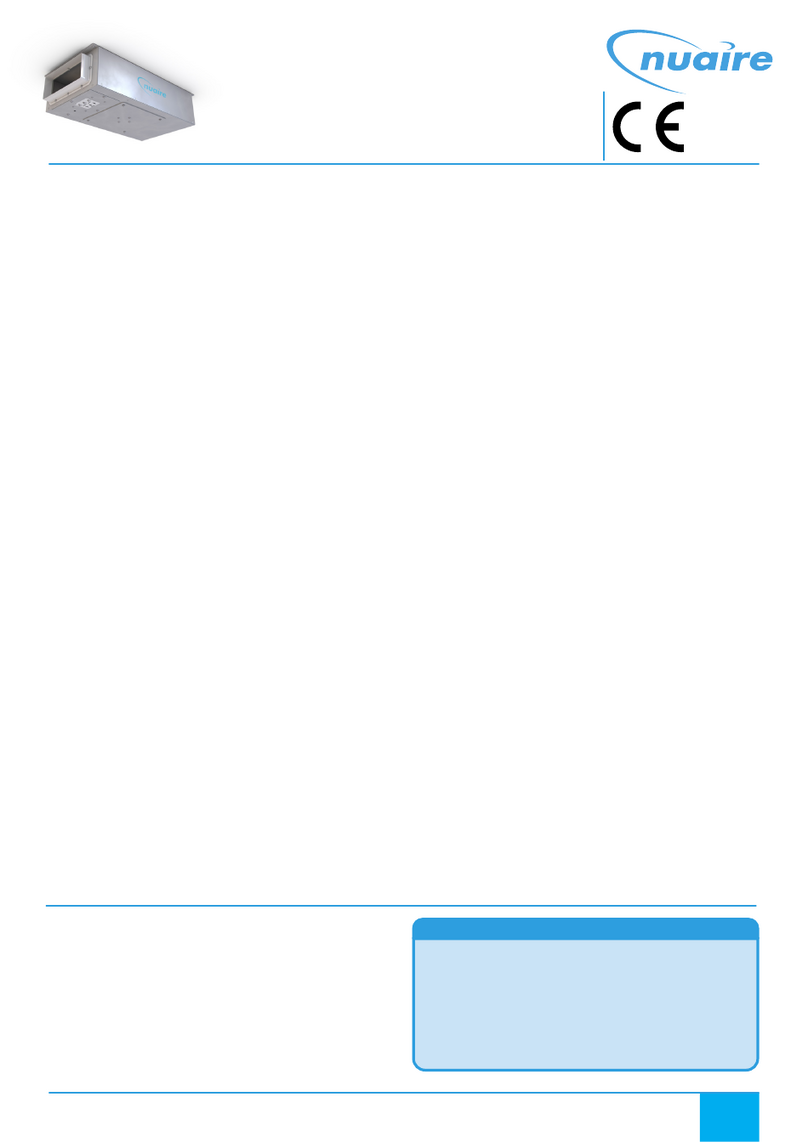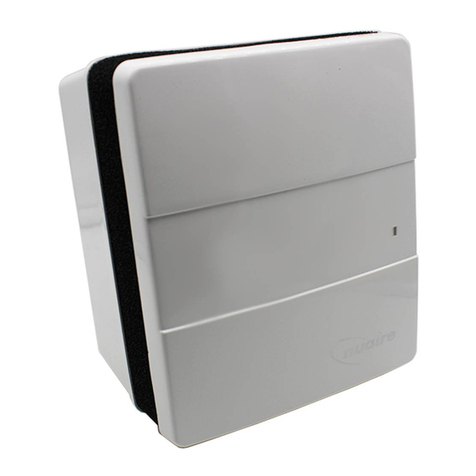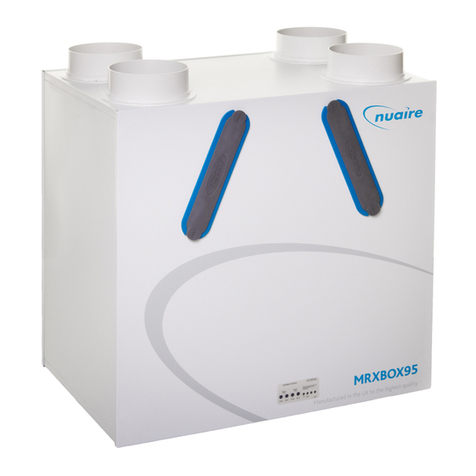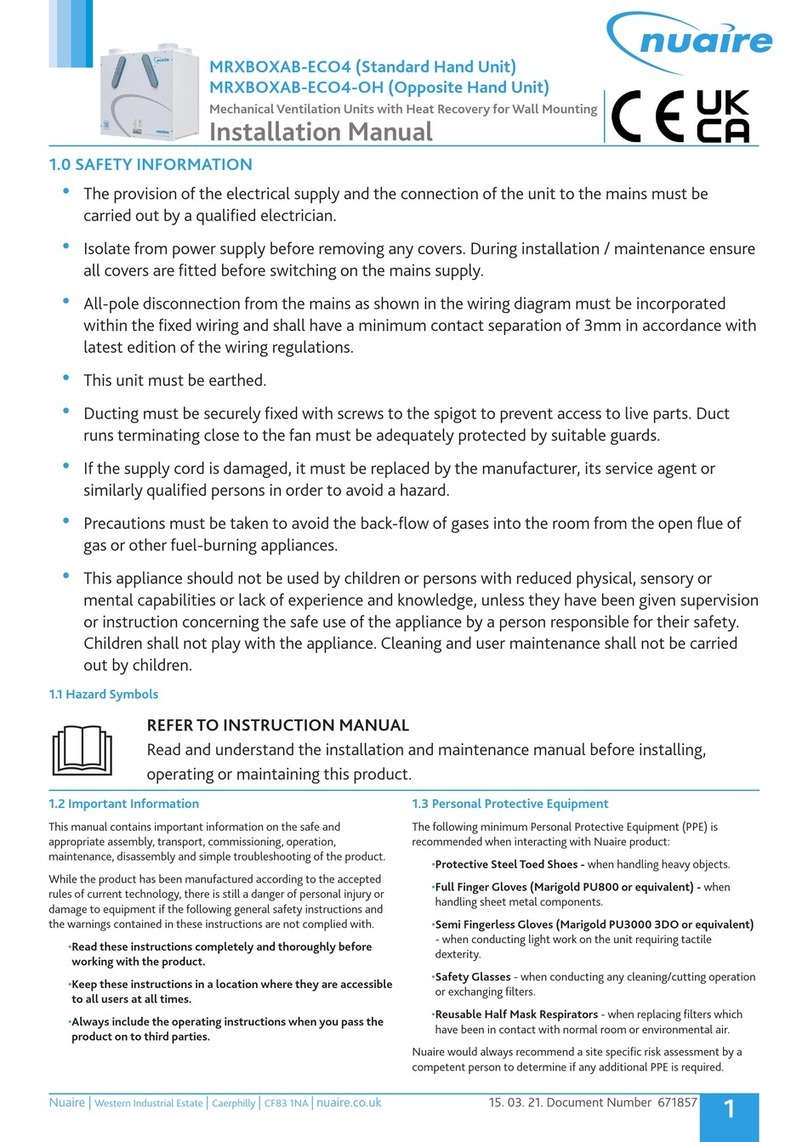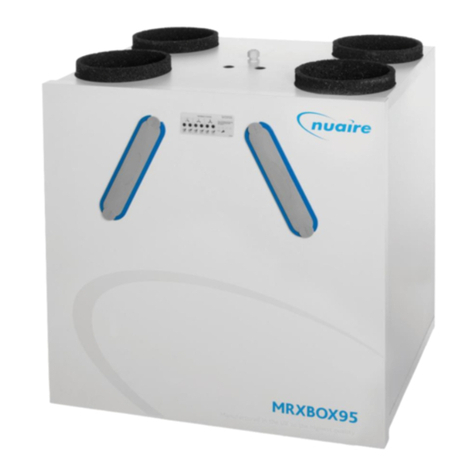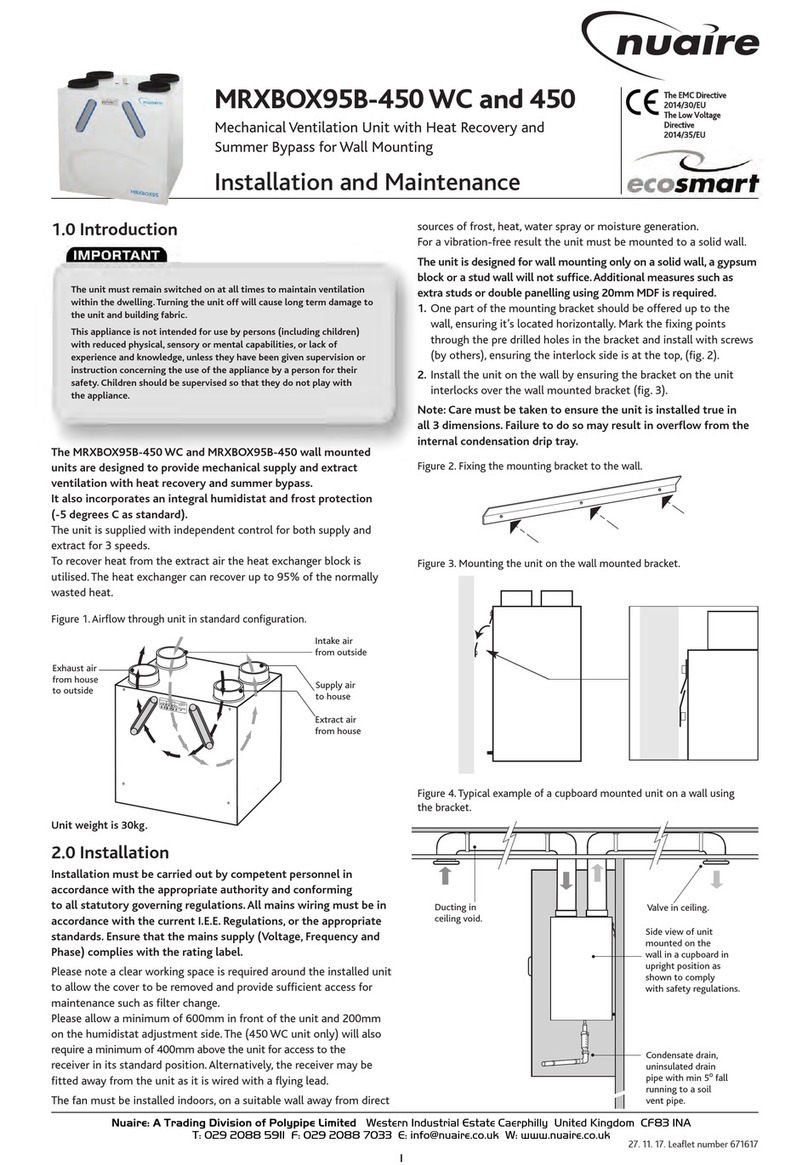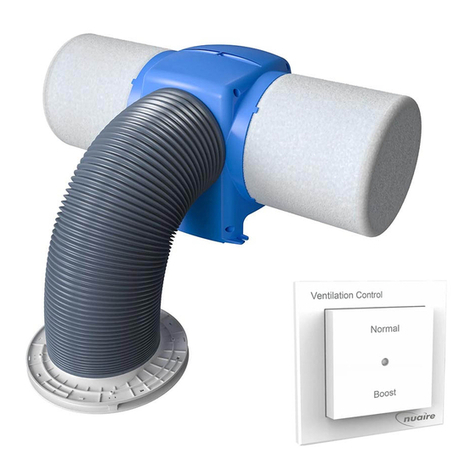
621. 10. 16. Leaflet Number 671169
DECLARATION OF INCORPORATION AND INFORMATION FOR SAFE INSTALLATION,
OPERATION AND MAINTENANCE
To comply w th EC Counc l D rect ves 2006/42/EC’ Mach nery D rect ve
and 2014/30/EU (EMC).
To be read n conjunct on w th the relevant Product Documentat on (see 2.1)
1.0 GENERAL
1.1 T e equipment referred to in t is Declarat on of Incorporat on is supplied by
Nuaire to be assembled into a ventilation system w ic may or may not include
additional components.
T e entire system must be considered for safety purposes and it is t e
responsibility of t e installer to ensure t at all of t e equipment is installed in
compliance wit t e manufacturers recommendations and wit due regard to
current legislation and codes of practice.
2.0 INFORMATION SUPPLIED WITH THE EQUIPMENT
2.1 Eac item of equipment is supplied wit a set of documentation w ic provides
t e information required for t e safe installation and maintenance of t e
equipment. T is may be in t e form of a Data s eet and/or Installation and
Maintenance instruction.
2.2 Eac unit as a rating plate attac ed to its outer casing. T e rating plate
provides essential data relating to t e equipment suc as serial number, unit
code and electrical data. Any furt er data t at may be required will be found
in t e documentation. If any item is unclear or more information is required,
contact Nuaire.
2.3 W ere warning labels or notices are attac ed to t e unit t e instructions given
must be ad ered to.
3.0 TRANSPORTATION, HANDLING AND STORAGE
3.1 Care must be taken at all times to prevent damage to t e equipment. Note t at
s ock to t e unit may result in t e balance of t e impeller being affected.
3.2 W en andling t e equipment, care s ould be taken wit corners and edges and
t at t e weig t distribution wit in t e unit is considered. Lifting gear suc as
slings or ropes must be arranged so as not to bear on t e casing.
3.3 Equipment stored on site prior to installation s ould be protected from t e
weat er and steps taken to prevent ingress of contaminants.
4.0 OPERATIONAL LIMITS
4.1 It is important t at t e specified operational limits for t e equipment are
ad ered to e.g. operational air temperature, air borne contaminants and unit
orientation.
4.2 W ere installation accessories are supplied wit t e specified equipment eg.
wall mounting brackets. T ey are to be used to support t e equipment only.
Ot er system components must ave separate provision for support.
4.3 Flanges and connection spigots are provided for t e purpose of joining to
duct work systems. T ey must not be used to support t e ductwork.
4.4 Local Env ronment - Hum d ty. Ambient umidity (t e umidity at t e unit’s
installed location) s all be wit in t e range: 10 to 95% (for controls, non-
condensing).
Air umidity (t e umidity of t e air passing t roug t e unit) s all be wit in
t e range: 10 to 95% (for controls, non-condensing).
5.0 INSTALLATION REQUIREMENTS
In addition to t e particular requirements given for t e individual product, t e
following general requirements s ould be noted.
5.1 W ere access to any part of equipment w ic moves, or can become electr cally
l ve are not prevented by t e equipment panels or by fixed installation detail
(eg ducting), t en guarding to t e appropriate standard must be fitted.
5.2 T e electrical installation of t e equipment must comply wit t e requirements
of t e relevant local electrical safety regulations.
5.3 For EMC all control and sensor cables s ould not be placed wit in 50mm or on
t e same metal cable tray as 230V switc ed live, lig ting or power cables and
any cables not intended for use wit t is product.
6.0 COMMISSIONING REQUIREMENTS
6.1 General pre-commissioning c ecks relevant to safe operation consist of t e
following:
Ensure t at no foreign bodies are present wit in t e fan or casing.
C eck electrical safety. e.g. Insulation and eart ing.
C eck guarding of system.
C eck operation of Isolators/Controls.
C eck fastenings for security.
6.2 Ot er commissioning requirements are given in t e relevant product documentation.
7.0 OPERATIONAL REQUIREMENTS
7.1 Equipment access panels must be in place at all times during operation of t e
unit, and must be secured wit t e original fastenings.
7.2 If failure of t e equipment occurs or is suspected t en it s ould be taken out of
service until a competent person can effect repair or examination. (Note t at
certain ranges of equipment are designed to detect and compensate for fan failure).
8.0 MAINTENANCE REQUIREMENTS
8.1 Specific maintenance requirements are given in t e relevant product documentation.
8.2 It is important t at t e correct tools are used for t e various tasks required.
8.3 If t e access panels are to be removed for any reason t e electrical supply to t e
unit must be isolated.
8.4 A minium period of two minutes s ould be allowed after electrical disconnection
before access panels are removed. T is will allow t e impeller to come to rest.
NB: Care should st ll be taken however s nce a rflow generated at some
other po nt n the system can cause the mpeller to “w ndm ll” even when
power s not present.
8.5 Care s ould be taken w en removing and storing access panels in windy
conditions.
INFORMATION FOR SAFE INSTALLATION, OPERATION AND MAINTENANCE
OF NUAIRE VENTILATION EQUIPMENT
We declare that the mach nery named below s ntended to be assembled
w th other components to const tute a system of mach nery. All parts
except for mov ng parts requ r ng the correct nstallat on of safety guards
comply w th the essent al requ rements of the Mach nery D rect ve. The
mach nery shall not be put nto serv ce unt l the system has been
declared to be n conform ty w th the prov s ons of the EC Mach nery
D rect ve.
Des gnat on of mach nery: ECOSMART SQURBO
Mach nery Types: ESS
Relevant EC Counc l D rect ves: 2006/42/EC (Mac inery Directive)
Appl ed Harmon sed Standards: BS EN ISO 12100, BS EN ISO 13857
EN60204-1, BS EN ISO 9001
Appl ed Nat onal Standards: BS848 Parts 1, 2.2 and 5
S gnature of manufacture representat ves:
Name: Position: Date:
1) C. Biggs Tec nical Director 22. 11. 13
2) A. Jones Manufacturing Director 22. 11. 13
Note: All standards used were current and valid at t e date of signature.

